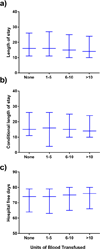Massive donor transfusion potentially increases recipient mortality after lung transplantation
- PMID: 28073574
- PMCID: PMC5392422
- DOI: 10.1016/j.jtcvs.2016.12.006
Massive donor transfusion potentially increases recipient mortality after lung transplantation
Abstract
Objective: Donor blood transfusion has been identified as a potential risk factor for primary graft dysfunction and by extension early mortality. We sought to define the contributing risk of donor transfusion on early mortality for lung transplant.
Methods: Donor and recipient data were abstracted from the Organ Procurement and Transplantation Network database updated through June 30, 2014, which included 86,398 potential donors and 16,255 transplants. Using the United Network for Organ Sharing 4-level designation of transfusion (no blood, 1-5 units, 6-10 units, and >10 units, massive), we analyzed all-cause mortality at 30-days with the use of logistic regression adjusted for confounders (ischemic time, donor age, recipient diagnosis, lung allocation score and recipient age, and recipient body mass index). Secondary analyses assessed 90-day and 1-year mortality and hospital length of stay.
Results: Of the 16,255 recipients transplanted, 8835 (54.35%) donors received at least one transfusion. Among those transfused, 1016 (6.25%) received a massive transfusion, defined as >10 units. Those donors with massive transfusion were most commonly young trauma patients. After adjustment for confounding variables, donor massive transfusion was associated significantly with an increased risk in 30-day (P = .03) and 90-day recipient mortality (P = .01) but not 1-year mortality (P = .09). There was no significant difference in recipient length of stay or hospital-free days with respect to donor transfusion.
Conclusions: Massive donor blood transfusion (>10 units) was associated with early recipient mortality after lung transplantation. Conversely, submassive donor transfusion was not associated with increased recipient mortality. The mechanism of increased early mortality in recipients of lungs from massively transfused donors is unclear and needs further study but is consistent with excess mortality seen with primary graft dysfunction in the first 90 days posttransplant.
Keywords: blood transfusion; lung transplantation.
Copyright © 2016 The American Association for Thoracic Surgery. Published by Elsevier Inc. All rights reserved.
Conflict of interest statement
The authors affirm no potential conflicts of interest.
Figures




Comment in
-
TRALI by proxy.J Thorac Cardiovasc Surg. 2017 May;153(5):1204-1205. doi: 10.1016/j.jtcvs.2017.01.036. Epub 2017 Feb 7. J Thorac Cardiovasc Surg. 2017. PMID: 28314528 No abstract available.
Similar articles
-
The Effect of Blood Transfusion in Lung Donors on Recipient Survival.Ann Thorac Surg. 2021 Oct;112(4):1109-1117. doi: 10.1016/j.athoracsur.2020.10.027. Epub 2020 Nov 21. Ann Thorac Surg. 2021. PMID: 33232728
-
Influence of Donor Transfusion on Heart Transplantation Outcomes: A United Network for Organ Sharing Registry Analysis.Clin Transplant. 2024 Dec;38(12):e70053. doi: 10.1111/ctr.70053. Clin Transplant. 2024. PMID: 39651615
-
Hospital length of stay after lung transplantation: Independent predictors and association with early and late survival.J Heart Lung Transplant. 2017 Mar;36(3):289-296. doi: 10.1016/j.healun.2016.07.020. Epub 2016 Aug 11. J Heart Lung Transplant. 2017. PMID: 27642060
-
Comparison of Prognosis for Lung Transplantation between Older and Younger Donors: A Systematic Review and Meta-Analysis Based on Cohort Studies.Ann Thorac Cardiovasc Surg. 2024;30(1):24-00092. doi: 10.5761/atcs.ra.24-00092. Ann Thorac Cardiovasc Surg. 2024. PMID: 39111865 Free PMC article.
-
Outcomes of marginal donors for lung transplantation after ex vivo lung perfusion: A systematic review and meta-analysis.J Thorac Cardiovasc Surg. 2020 Feb;159(2):720-730.e6. doi: 10.1016/j.jtcvs.2019.07.087. Epub 2019 Aug 25. J Thorac Cardiovasc Surg. 2020. PMID: 31548078
Cited by
-
Lung Volume Reduction Followed by Lung Transplantation in Emphysema-A Multicenter Matched Analysis.Transpl Int. 2022 Apr 14;35:10048. doi: 10.3389/ti.2022.10048. eCollection 2022. Transpl Int. 2022. PMID: 35497884 Free PMC article.
-
Heparin-free veno-arterial extracorporeal membrane oxygenation in lung transplantation: a retrospective cohort study.J Cardiothorac Surg. 2024 Apr 20;19(1):255. doi: 10.1186/s13019-024-02721-y. J Cardiothorac Surg. 2024. PMID: 38643128 Free PMC article.
-
The impact of bleeding on outcomes following lung transplantation: a retrospective analysis using the universal definition of perioperative bleeding.J Cardiothorac Surg. 2024 Jul 25;19(1):466. doi: 10.1186/s13019-024-02952-z. J Cardiothorac Surg. 2024. PMID: 39054519 Free PMC article.
-
New Aspects of Lung Transplantation: A Narrative Overview Covering Important Aspects of Perioperative Management.Life (Basel). 2022 Dec 28;13(1):92. doi: 10.3390/life13010092. Life (Basel). 2022. PMID: 36676041 Free PMC article. Review.
-
Thoracoabdominal Normothermic Regional Perfusion and Donation After Circulatory Death Lung Use.JAMA Netw Open. 2025 Feb 3;8(2):e2460033. doi: 10.1001/jamanetworkopen.2024.60033. JAMA Netw Open. 2025. PMID: 39960670 Free PMC article.
References
-
- Naik PM, Angel LF. Special issues in the management and selection of the donor for lung transplantation. Seminars in immunopathology. 2011;33(2):201–210. - PubMed
-
- Christie JD, Edwards LB, Kucheryavaya AY, et al. The Registry of the International Society for Heart and Lung Transplantation: 29th adult lung and heart-lung transplant report-2012. The Journal of heart and lung transplantation : the official publication of the International Society for Heart Transplantation. 2012;31(10):1073–1086. - PubMed
-
- Valapour M, Paulson K, Smith JM, et al. OPTN/SRTR 2011 Annual Data Report: lung. American journal of transplantation : official journal of the American Society of Transplantation and the American Society of Transplant Surgeons. 2013;13(Suppl 1):149–177. - PubMed
-
- Webert KE, Blajchman MA. Transfusion-related acute lung injury. Transfusion medicine reviews. 2003;17(4):252–262. - PubMed
Publication types
MeSH terms
Grants and funding
LinkOut - more resources
Full Text Sources
Other Literature Sources
Medical

